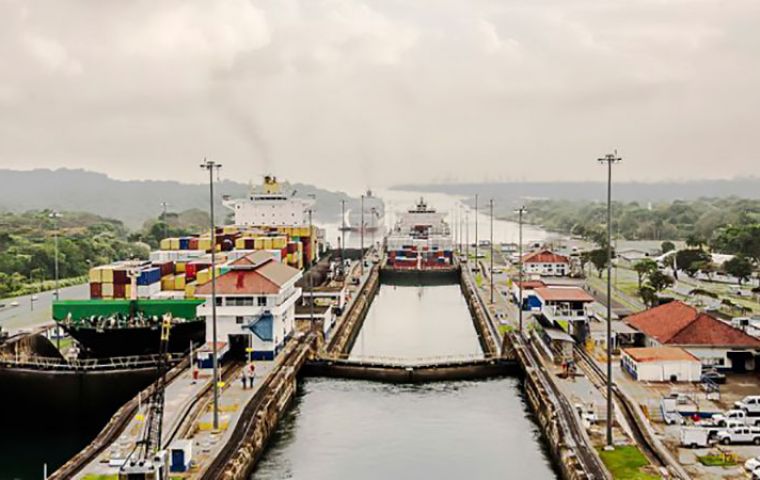MercoPress. South Atlantic News Agency
Shortage of rain water threatens Panama Canal crossings forcing ships to reduce their draft and cargoes
 Alhajuela and Gatún are the two artificial lakes in the Caribbean province of Colón that supply water to the canal, and both have been affected by the drought
Alhajuela and Gatún are the two artificial lakes in the Caribbean province of Colón that supply water to the canal, and both have been affected by the drought Insufficient rainfall has once again forced the Panama Canal to reduce the draft of ships crossing through the inter-oceanic route – another episode of the water supply crisis that threatens the future of the maritime course that handles 6% of global maritime trade
“The lake Alhajuela is running out of water every day,” laments Leidín Guevara, a 43-year-old Panamanian self-employed worker who fishes in the area twice a month. On the dry land next to the lake, he states that this has been the most brutal drought he has witnessed in the region.
Alhajuela and Gatún are the two artificial lakes in the Caribbean province of Colón that supply water to the canal, and both have been affected by the drought. This situation led the ACP (Panama Canal Authority) to limit the depth of the largest vessels that transit through the canal for the fifth time.
In the Panama Canal, rainwater is the energy source responsible for moving ships through the locks, which function like elevators that lift the vessels up to 26 meters above sea level to cross the continental divide.
The transit of vessels requires about 200 million liters of freshwater to be dumped into the sea, making Alhajuela and Gatún lakes vital for the canal’s operation. However, according to the ACP, from March 21 to April 21 of this year, water levels in Alhajuela dropped from 69 to 62 meters, while in Gatún, they went down from 25.6 to 25.2 meters. Although the crisis has worsened, all alarms went off in 2019 when only 3 billion cubic meters of the 5.25 billion cubic meters of fresh water needed for the route were available.
“The lack of rain affects us on various fronts, mainly in the reduction of our water reserves,” said Erick Córdoba, Water Manager of the ACP. The crisis also impacts operations by reducing the passage of Neopanamax ships – the largest that transit through the canal and the ones that pay the largest fees.
In 2022, more than 14,000 vessels with 518 million tons of cargo crossed the Panama Canal, generating US$2.5 billion for the Panamanian treasury. Fearing that shipping companies may decide to use other routes and cause a hole in the country’s GDP, authorities are seeking alternatives to ensure the canal’s long-term operations.
Speaking with local news site SNIP Notícias, the canal’s administrator, Ricaurte Vásquez, stated that water scarcity is one of the biggest threats to the strait. “Water represents a limiting element to this country’s ability to sustain the Panama Canal as a relevant freight route,” he said.
Former canal administrator Jorge Quijano said the situation could take away the canal’s growth capacity. “It is essential to find new sources of water, especially in the face of the ever-present climate change, not only in our country but throughout the world,” he said.
Luz de Calzadilla, Director General of the Panama Institute of Meteorology and Hydrology, pointed out that the canal saw a precipitation deficit but was “within the normality of what is a dry season.” However, there is a “high probability” that the country will be impacted in the second half of the year by the El Niño climatic phenomenon, characterized by less rainfall.
“The truth is that the canal administration works magic to maintain the business and fulfill a social responsibility such as providing drinking water for human consumption,” she adds.




Top Comments
Disclaimer & comment rulesCommenting for this story is now closed.
If you have a Facebook account, become a fan and comment on our Facebook Page!